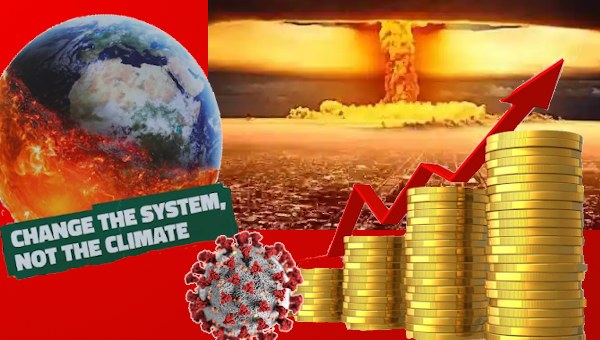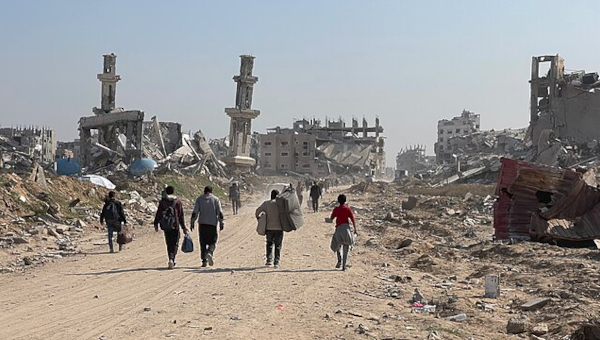The US, Russia and Ukraine: Thinking Beyond the New Cold War and World War 3
Putin’s regime, unlike Franco, Mussolini, or Hitler, has a formidable nuclear arsenal. In this context, the contemporary world stands on the brink, facing extinction either through nuclear holocaust emanating from battle fields in Ukraine or from the ever-worsening climate crisis. Meanwhile, in our everyday lives, prices for food and petrol are skyrocketing. Precariousness, uncertainty, and complex risk have become the lived reality of deep globalization in which markets for finance, energy, food, and production have been integrated.
The fragility of this global economy was exposed in the ‘great financial crisis’ (circa 2007-2009) from which the world economy still has not recovered, as well as by the ongoing COVID-19 pandemic, and now, the Russian invasion of Ukraine. These realities cannot be understood through simple memes, propagandistic binaries, or abstract security concepts. The stakes are too high.
A global historical process has brought us to where we are, a political project to remake the world in the image of, and for the benefit of, the USA after the end of the Cold War. Four decades later, this project has clearly failed and is driving all of us deeper into a death trap. Yet the leadership of the USA and its allies continues to repeat the same mistakes. If we do not grasp this premise as the basis to understand the world disorder, we are not going to escape this madness. Moreover, we will not be able to think through nor find a way out of this crisis and will remain hostage to a paradigm of war shared by the US, the EU, Russia, and China. Utilising a more nuanced and critical geo-strategic reading of the US policy and actions, the Russian invasion of Ukraine, and the invasion’s wider implications will illustrate the point.

The Stakes are High
Many security strategists and media commentators, mainly in the West, characterise the invasion of Ukraine as the inauguration of ‘World War 3’ or a ‘new Cold War’. This framing defines international politics by setting up two opposing sides with distinct ideological orientations: the liberal West versus the authoritarian Russian Federation and China. This narrative has immense common-sense appeal but does not correspond to reality. In fact, US democracy sits on the same authoritarian spectrum as Russia and China. It is a failed market democracy, best designated as a plutocracy, in which it has given overwhelming power to corporations over citizens.
The Republican Party is also the harbinger of a minority project based on supremacist white nationalism, including voter-suppression laws in several states. US democracy looks more like a ‘racist banana Republic’ than a shining example of democratic rights and freedoms. Moreover, this binary geo-political frame is dangerous because it reinforces a paradigm of war which serves the interests of countries with large military-industrial-security complexes, countries that believe war is necessary to order international relations. Philosophically, this notion rests on simplistic and static conceptions of human nature as inherently violent. Both World Wars in the 20th century led to immense loss of life, about 80 million people, as well as scorched eco-systems.
While the US likes to believe it won the Cold War through outspending the former USSR in an arms race, the fact of the matter is that Mikhail Gorbachev and his party realized, after decades of building nuclear arsenals and chemical and biological weapons, that the geopolitics of the Cold War was a dead end for humanity; nobody wins if we all self-exterminate. By the 1960s, both sides had nuclear weapons that could vaporize cities the size of Cape Town and Johannesburg. No matter what military doctrine and narrative was used to justify nuclear weapons, these technologies of mass annihilation were never about deterrence but essentially about first-strike extermination of millions of human beings. About forty recorded nuclear incidents occurred during the forty-five-year Cold War, including accidents involving planes and submarines armed to the teeth with nuclear warheads. Our world could have ended during the Cold War because none of the safeguards really worked. A whole generation living on our planet today does not understand this threat.
Most of the public also do not appreciate that nuclear war fighting has become ingrained in how the USA understands its superiority in the world. After the Cold War, instead of embracing Gorbachev’s invite to secure a nuclear-weapons-free world, the US leadership did the opposite. It failed to sign on to the Nuclear Test Ban Treaty and take seriously the call for the reduction of nuclear arms and strategic ballistic missiles. Instead, it steamed ahead with the wrong-headed assumption that nuclear capability, both strategic and tactical, was necessary to complement conventional military capabilities. In the 1990s, Russia’s military budget collapsed, and its nuclear arsenal was put into storage. However, other nuclear powers such as Britain, France, and China followed the US lead. Putin jumped on this band wagon once ensconced in the Kremlin, propped up by criminalized petro-capitalism (aided by US corporations), as NATO expanded east and his revanchist ultra-nationalist dreams of territorial empire took shape. The world has to ask: why has the USA not produced a Gorbachev? Why is the USA, which has had the power to lead by example, not actively worked to prevent nuclear proliferation after the end of the Cold War? Where is the American leader that can ensure Israel, India, Pakistan, North Korea, and all other nuclear powers terminate their nuclear arsenals and ambitions by showing that the US will do the same for world peace?
Militarist expansionism has its roots deep in US history, going back to early frontier expansion and genocidal violence against native Americans. In the 19th century, these events were married to the notion of ‘manifest destiny’, that is, the divine right to expand the territorial boundaries of the US. Hence, throughout its modern history, the US has had a selective respect for international law, including the UN Charter. This was demonstrated starkly during the Cold War when US trained militaries in the infamous School of the America’s overthrew democratically elected governments in Latin America. In the so-called ‘US backyard’ and beyond, about ten million people were killed during ‘hot wars’ in the global south. For Noam Chomsky, this US interventionism was tantamount to fascism, and up to now, there has been no reckoning. In the aftermath of the Cold War, the US continues this hypocrisy through violations of human rights, illegal invasions, and extra judicial killings during its ‘war on terror’. Putin is a good student of US hypocrisy and is putting it to the test in his own maniacal way. However, some misread Putin and his de-nazification rhetoric as progressive anti-imperialism.
New Global Warfare
In the post-Cold-War world, based on a complex weave of fragile economic integration, the US also trail blazed with a new form of global warfare, adding to its nuclear, chemical, and biological weapons capability. The new war machine is made up of three elements: (i) full-spectrum dominance (including air, land, sea, space, and the cybersphere); (ii) hybridizing full spectrum warfare with economics, extra-judicial actions, embedded journalism, and even multi-lateral relations; and (iii) expanding the US’s global reach. One result is the production of copy cats like the Putin regime. This war machine and national security orientation, nonetheless, has a contradictory relationship with its ambitions for global economic integration. Global war constantly disrupts economic circuits and introduces instability into the global economy. The first Gulf War had implications for oil supplies, the failed ‘war on terror’ created risk all over the world, and US involvement in Syria added to the tragic refugee crisis (which did not receive the same commitment to humanitarian aid as Ukraine, but instead, exclusionary border regimes were utilized by European countries).
Current sanctions against Russia, including oil and gas bans by the US and UK, have led to a spike in global oil and gas prices and triggered a food and fertilizer export ban from Putin, which, in turn, has caused a price spike and global food shock. The logic of global war within US national security thinking has explicitly been about a collision with declared ‘rivals’ such as Russia and China, ensnaring them in a spiral of escalation, including defensive and dangerous pre-emptive moves. Both Trump and Biden’s national security thinking fit this template. Even if Putin withdraws from Ukraine, the US is certainly on a war path against China. Does the American public want this? Will the US plutocratic rulers democratize US Foreign Policy, including having a national referendum on such an issue? Does the world want this kind of explicit war mongering that threatens everything?
The decline of the US and its inability to think beyond the global war paradigm was also on full display before and after Putin’s recent invasion of Ukraine. The faltering Minsk agreements, after Russia’s invasion of Crimea in 2014, and the amassing of a sizeable number of Russian troops on the Ukrainian border over the past few months should have given the US and its EU allies pause to secure a lasting peace. Instead, aid packages have kicked into gear mainly to militarise the conflict. Both the US and EU have escalated the conflict with increasing military resourcing and, thus, have reduced Ukraine to a military proxy of the US-EU-Nato Alliance.
Failure by the EU
The EU, in particular, has failed spectacularly to incorporate Russia into a pan-European project and break out of the shadows of US power. After the Cold War, a London-Paris-Berlin-Moscow project was a distinct possibility. Again, embracing the peace opening inaugurated by Gorbachev was dismissed. Instead, selective geo-strategic relations were maintained with Russia for commodities and for laundering dirty oligarchic finance, mainly through London. Germany and the EU are now remilitarizing and embracing the US global war paradigm. Together with BREXIT, rising ultra-nationalism, deepening economic crisis, and worsening climate shocks, the EU project faces serious challenges.
With growing signs of a shift toward robotized warfare (including drones, roboticised guard dogs on the US border, and the robot soldier), the US is laying the basis to take the world into endless global warfare. The US military has one of the largest carbon footprints in the world; some studies show it has a carbon footprint larger than Portugal or Denmark. Biden’s administration has just secured a bi-partisan military budget worth close to $800-billion while at the same time allocating only $100-billion to assist poor countries with the climate crisis, a problem it has played a major part in creating. And also at the same time, in the midst of the conflict with Russia, it has called on US shale oil and gas producers to increase supply, as well as Saudi Arabia and Venezuela to also meet global supply needs. The European Union as well is faltering in terms of using this moment to break its dependence on fossil fuels. Recent studies show that the world will cut emissions only by 9% by the end of the decade rather than by half, which means the world risks overshooting the 1.5C target. Meanwhile, the UN IPCC, in its recent report on Climate Impacts, Adaptation and Vulnerability, says over three billion people are now vulnerable to current levels of planetary heating.
Failure by the USA
The Cold War wasted the talents and skills of two generations. The world cannot afford to repeat this mistake. All scholarly security thinking today highlights the climate crisis as the primary complex threat facing the world; the entire world needs to commit to confronting this challenge. The US is brazenly failing to take responsibility for its contribution to the worsening climate crisis and has, in fact, become a threat multiplier in both military and climate terms to the world. Is it time for climate justice sanctions against the US and those like it? Russia, China, and the EU are no different if they remain within the US death trap. All these geo-political competitors certainly do not represent the interests of the greatest super power on planet earth: the human species.
Even with a ceasefire between Russia and Ukraine, based on commitments not to join NATO and security guarantees, the situation in Eastern Europe is going to be tenuous; there will be no lasting peace. Hence, at minimum, anti-war politics today has to stand for a nuclear-free Europe and world (already billions of people in Africa, Latin America, and parts of Asia are in nuclear-free zones); a renewed social-, rather than market-centered Pan European project embracing both Ukraine and Russia; an end to NATO; the termination of war machines driving endless global war in Ukraine, Palestine, Yemen, and elsewhere; extending support to all refugees on the planet, including enhancing humanitarian aid to Ukraine through cancelling all foreign debts; and an end to the war with nature, particularly the climate crisis, by immediately phasing out fossil fuels and going beyond a politics of nationalism to embrace a politics of human and non-human solidarity.
It’s time for collective human power to prevail over those who threaten all of us before it is too late. For example, the South African government in its ‘neutrality’ stance is far from these concerns and is stuck in outdated geo-strategic and security thinking. It needs to utilize the termination of the apartheid nuclear arsenal and chemical and biological warfare program to echo the imperatives of contemporary anti-war politics on the global stage: in the African Union, the United Nations, the BRICS, and in engagements with the US, EU, and Ukraine. •
This article first published on the Daily Maverick website.





